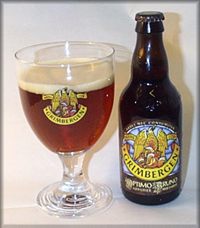|
|||
|
Philatelia.Net / Beer / Plots / The directory «Plots»GrimbergenThe magnificent abbey of Grimbergen is in the village of the same name, just to the north of Brussels, Belgium. The village, its streets lined with cherry trees, is today a suburb of the city. Grimbergen is one of the few surviving abbeys to have been established by the founder of an order, in this instance St Norbert (1080-1134). Norbert founded the order in Prémontré, near Rheims, and just north of what is now Champagne country. The order is sometimes described as Norbertine and other occasions by the clumsy description Praemonstratensian. The abbey of Grimbergen was founded in 1128. It was destroyed in various local wars in the same century, the 1500s. Its present church, a magnificent example of Flemish-baroque architecture, was built in the 1600s. After being secularised during the French Revolution, much of the abbey was rebuilt in the 1830s, and it was further restored in the 1920s. The abbey almost certainly had a brewery from its earliest days, and there are mentions of one in the 1600s. In the 1700s, there are mentions of wheat beers and abbey hop garden. Brewing stopped at the time of the French Revolution. When the abbey was re-established, beer was supplied by a local brewer, now long-gone. In 1958, the monks asked the nearby Maes brewery to make beer for them. In 1982, production switched to Maes' subsidiary ale brewery in Jumet, Charleroi, in the South of the country. In Belgium, the Norbertine abbeys of Leffe and Tongerlo have similar arrangements with other brewers. Yet further brewers make beers recalling the names of former abbeys in the same order such as Bonne Espérance, Floreffe and St Feuillien. Other beers are made either to benefit or remember abbeys of other orders such as the Benedictines, Augustinians and Cistercians. All of these products are known simply as "abbey" beers (in Flemish, Abdij; in French Abbaye). So are beers in much the same style dedicated to long-vanished abbeys, ruins, or local saints, for example. One Cistercian abbey in Belgium has a brewery on its premises. So do six Trappist monasteries. The latter are exclusively entitled to use the term Trappist on their labels. Some abbeys have beers called Single, Double and Triple, to indicate an ascending order of alcohol content. Typically, the single is served to the brothers with their meals, and is often unavailable outside the abbey. The Double and Triple may be served in the abbey on religious holidays, but are likely to be primarily sold outside. The prime role of all abbey and Trappist beers is to raise money for the maintenance of the communities and their work. All of the abbey beers are ales, usually strong, and often Dark (though most of the Triples are pale, following the style of the most famous example, from Westmalle). Despite no longer having its own brewery, Grimbergen is conscious of its beery history. The prelate often delivers the sermon at the annual mass in Brussels to celebrate beer. Grimbergen's range includes a dark double (in Flemish, Dubbel) and a golden Triple (in Flemish, Tripel). The Double has an alcohol content of 5.2 per cent by weight, 6.5 by volume. It has a Burgundy color, a raisiny aroma; an orangey, toffeeish palate; and a cinnamon-like, spicy, brandyish, finish. Belgium, 1978, Grimbergen Abbey Advertising: |
|||
© 2003-2024 Dmitry Karasyuk. Idea, preparation, drawing up
|

